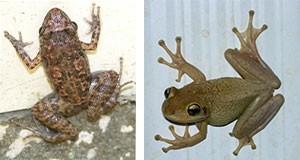Abstract
Frogs control garden pests such as insects and slugs, and serve as a food source for many larger wildlife species. Research on the substances frogs secrete through their skins has even led to the creation of new painkillers and antibiotics. Most frogs in Florida are reclusive and harmless to people, but two species of frogs that have invaded Florida can be harmful to humans and their pets. This 4-page fact sheet presents some facts about native frogs, describes the problems invasive frogs cause, and provides suggestions on how to cope with problem frogs. Written by Steve Johnson, Holly K. Ober, and William M. Giuliano, and published by the UF Department of Wildlife Ecology and Conservation, November 2014. (Photos: Steve Johnson, UF/IFAS)
WEC349/UW394: Managing Conflicts with Wildlife: Living with Frogs (ufl.edu)
References
UF/IFAS-The Cuban Treefrog In Florida: https://edis.ifas.ufl.edu/uw259
UF/IFAS-Invasive Cuban Treefrogs website: http://ufwildlife.ifas.ufl.edu/cuban_treefrog_inFL.shtml
FWC-Cuban Treefrogs: http://myfwc.com/wildlifehabitats/nonnatives/amphibians/cuban-treefrog/
UF/IFAS-Florida Invader Cane Toad: https://edis.ifas.ufl.edu/uw345
FWC-Giant Toads: http://myfwc.com/wildlifehabitats/nonnatives/amphibians/giant-toad/

